Sucia Island
Sucia Island (/ˈsuːʃə/) is located 2.5 miles (4.0 km) north of Orcas Island in the San Juan Islands, San Juan County, Washington, United States. It is the largest of an archipelago of ten islands including Sucia Island, Little Sucia, Ewing, Justice, Herndon, the Cluster Islands islets, and several smaller, unnamed islands. The group of islands is about 2.5 miles (4.0 km) in length and just short of a half mile wide. Sucia island is roughly the shape of a hand. The total land area of all islands is 2.74 km2 (1.058 sq mi, or 677 acres). The main island of Sucia Island by itself is 2.259 km2 (0.8722 sq mi, or 558.1 ac). There was a permanent population of four persons as of the 2000 census, all on Sucia Island. Sucia Island State Park is a Washington State Marine Park.
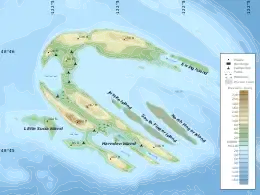 Map of Sucia and surrounding islands | |
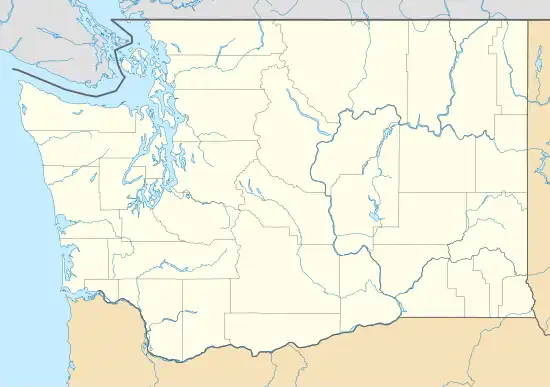 Sucia Island Location within the US state of Washington | |
| Etymology | from Spanish 'dirty, foul' |
|---|---|
| Geography | |
| Location | Strait of Georgia |
| Coordinates | 48°45′13″N 122°54′48″W |
| Archipelago | Sucia Islands |
| Adjacent to | Echo Bay, Shallow Bay, Fossil Bay, Mud Bay, Snoring Bay |
| Administration | |
United States | |
| State | Washington |
| County | San Juan |
| Demographics | |
| Population | 4 (2000) |
History
Sucia Island's name originated with the Spanish Captain Francisco de Eliza, on his map of 1791. He named it "Isla Sucia". Sucia in Spanish means "dirty" or in a nautical sense "foul". This word was chosen because the shore was deemed dangerous due to reefs and hidden rocks.[1]
These reefs and broken shorelines are from a geologic folding of the Earth's crust, which brought many interesting marine fossils to the surface. Some good examples can be found on the southeast arm of Sucia Island.
The isolated coves and bays of Sucia Island once served the Lummi Indians in their seal hunting days.[2] They later provided excellent hideouts in the 19th century for smugglers of illegal Chinese laborers, as well as for hiding illegally imported wool and opium. Still later, the islands played a large role in rum-running during liquor Prohibition of the 1920s and 1930s, and in recent years they have figured in drug trafficking.
The first known Euro-American settler on the island was Charles Henry Wiggins, who moved to the island in the 1880s with his wife, Mary Luzier, a Cowlitz Indian. The Wiggins family had lived previously on nearby Waldron Island, but left for Sucia after government agents seized eight of their children and took them to Chemawa Indian School in Salem, Oregon. The couple had five more children on Sucia and established a farm with fruit trees, cows and sheep. Wiggins Head at the southeast end of the island is named for the family.[3]
The cluster of Sucia Islands was purchased in 1960 by the Puget Sound Interclub Association and later donated to the State of Washington for protection as a Marine State Park.
In 2012, paleontologists Christian Sidor and Brandon Peecock discovered a fossilized femur bone from a theropod dinosaur on the island's shore. This was the first dinosaur fossil discovered in Washington state. Given the lack of other fossils from the dinosaur, it's unclear exactly which species of theropod the bone came from.[4][5]
Activities
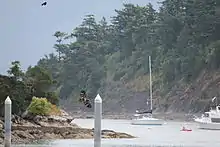
- Camping
- Birdwatching
- Hiking
- Rock Climbing
- Kayaking
- Fishing
- Scuba diving
- Crabbing
These activities can be accessed from Sucia Island State Park and the Echo Bay Campground.[6][7]
Anchorages
Shallow Bay
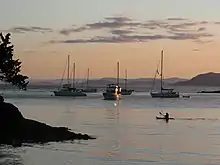
Shallow Bay on the island's west side is protected from all but westerly winds and waves. There are seven mooring buoys and room for 40-50 small pleasure craft in this anchorage. There are beaches on three sides including a sandy beach to the north. Pebble Beach in the center is the access point to the camping and moorage pay box, as well as a large group camping site with a covered eating area and environmentally friendly composting out-houses. True to its name, Shallow Bay averages 12 feet (3.7 m) deep. The anchor holding is good in sand but may be more rocky towards the center and mouth of the bay.
Echo Bay
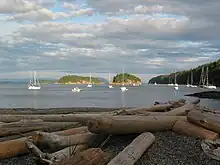
Echo Bay is directly opposite the island's narrow isthmus from Shallow Bay and the largest of the anchorages, and the most exposed, particularly to southeast winds. There are a number of mooring buoys close to a pebble beach.
Fossil Bay
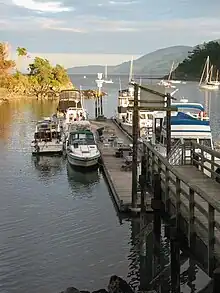
Fossil Bay is one of the most popular anchorages, particularly for small boats that prefer to tie up to one of two docks rather than anchor or pick up a mooring ring. Fossil Bay is an inlet that opens to the southeast.
Fox Cove
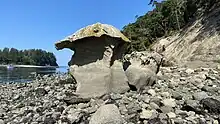
Fox Cove lies just west of and can be seen from Fossil Bay. Fox Cove is bordered by Ev Henry Finger point and Little Sucia island.
Ewing Cove
Ewing Cove is between the northeast end of Sucia island and Ewing Island. There is room for several boats at anchor or at a mooring buoy. The pebble beach at Ewing Cove is at the end of a 2.1-mile (3.4 km) trail to the center of the island.
References
Notes
- Phillips, James W. (1971). Washington State Place Names. University of Washington Press. ISBN 0-295-95158-3.
- Lund, John; Toor, Marianne van (September 1, 2008). "A Natural Attraction". Sea Magazine.
- "Historical information". Sucia Island Marine State Park. Washington State Parks and Recreation Commission. Retrieved May 21, 2023.
- "Introducing Washington's first dinosaur". Burke Museum. Retrieved May 16, 2023.
- Peecook, Brandon R.; Sidor, Christian A. (May 20, 2015). "The First Dinosaur from Washington State and a Review of Pacific Coast Dinosaurs from North America". PLOS One. 10 (5): e0127792. doi:10.1371/journal.pone.0127792. ISSN 1932-6203. PMC 4439161. PMID 25993090.
- "Sucia Island State Park". Retrieved September 25, 2020.
- "The Chatty Housewife". Retrieved September 25, 2020.
General references
- Sucia Island group: Blocks 2000 thru 2005, Census Tract 9601, San Juan County, Washington United States Census Bureau
- Rosario Strait to Cherry Point (Map) (9th ed.). 1:25,000. Washington, D.C.: U.S. Department of Commerce. May 2014. 18431.
External links
- Sucia Island State Park | Washington State Parks and Recreation Commission
- San Juan Islands Marine Parks, Maps and Pictures.
- Image of sailor Davey at Fox Cove, Sucia Island, San Juans
- Sucia - San Juan Islands, WA, boat trip video
- U.S. Geological Survey Geographic Names Information System: Sucia Island
- U.S. Geological Survey Geographic Names Information System: Sucia Islands (archipelago)
